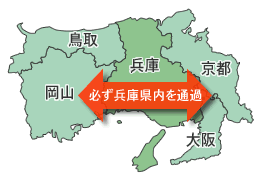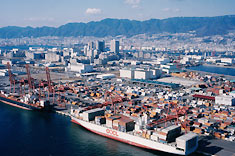Here's what makes us different! Four benefits of expanding into Hyogo

Hyogo Prefecture, located almost in the center of Japan, stretches from the Sea of Japan through the Seto Inland Sea to the Pacific Ocean. Its vast land area boasts one of Japan's leading expressway networks, Hanshin Port, designated as an international strategic container port, as well as Kansai International Airport, Osaka International Airport, and Kobe Airport, providing a comprehensive and well-developed transportation network by land, sea, and air.
 Hyogo Prefecture borders Osaka Prefecture and Kyoto Prefecture to the east, and Okayama Prefecture and Tottori Prefecture to the west, and is the only prefecture on Honshu that faces the sea on both the north and south sides, except for the two ends.
Hyogo Prefecture borders Osaka Prefecture and Kyoto Prefecture to the east, and Okayama Prefecture and Tottori Prefecture to the west, and is the only prefecture on Honshu that faces the sea on both the north and south sides, except for the two ends.
As such, our prefecture stretches across Honshu from the Sea of Japan side to the Pacific side, and is characterized by the fact that land transport occurring east of Kinki and west of Chugoku and Shikoku always passes through the prefecture.
 Hyogo Prefecture itself has major metropolitan areas such as Kobe City and the Hanshin region, but it is adjacent to Osaka, the core hub of the Kansai region, and has developed as an integrated economic sphere with Osaka.
Hyogo Prefecture itself has major metropolitan areas such as Kobe City and the Hanshin region, but it is adjacent to Osaka, the core hub of the Kansai region, and has developed as an integrated economic sphere with Osaka.
For this reason, Hyogo Prefecture has a large concentration of large-scale production bases within the prefecture and in neighboring cities, as well as a large population concentration in the surrounding area, and is characterized by its excellent proximity to major production and consumption areas.
 Hyogo Prefecture faces Osaka Bay, the Seto Inland Sea, and the Sea of Japan, and boasts a diverse coastline stretching approximately 840 km. It also has 30 ports, ranging from international trade ports such as Kobe Port, Himeji Port, Amagasaki Nishinomiya Ashiya Port, and Higashi-Harima Port, to local ports that support local communities, and boasts one of the highest cargo handling volumes in the country.
Hyogo Prefecture faces Osaka Bay, the Seto Inland Sea, and the Sea of Japan, and boasts a diverse coastline stretching approximately 840 km. It also has 30 ports, ranging from international trade ports such as Kobe Port, Himeji Port, Amagasaki Nishinomiya Ashiya Port, and Higashi-Harima Port, to local ports that support local communities, and boasts one of the highest cargo handling volumes in the country.
In particular, Kobe Port, which has developed as an international port city, is a leading container port with a network connecting it to over 500 ports in over 130 countries and regions around the world.
We aim to create an air network that can respond to the increasing demand for air travel, and to make Hyogo Prefecture an airport-side prefecture that can respond to the era of great international exchange in the 21st century.
Location characteristics 1 All land transport between Kinki and east and Chugoku and Shikoku and west passes through Hyogo Prefecture.
 Hyogo Prefecture borders Osaka Prefecture and Kyoto Prefecture to the east, and Okayama Prefecture and Tottori Prefecture to the west, and is the only prefecture on Honshu that faces the sea on both the north and south sides, except for the two ends.
Hyogo Prefecture borders Osaka Prefecture and Kyoto Prefecture to the east, and Okayama Prefecture and Tottori Prefecture to the west, and is the only prefecture on Honshu that faces the sea on both the north and south sides, except for the two ends.As such, our prefecture stretches across Honshu from the Sea of Japan side to the Pacific side, and is characterized by the fact that land transport occurring east of Kinki and west of Chugoku and Shikoku always passes through the prefecture.
Location characteristics 2 Excellent proximity to major production and consumption areas
 Hyogo Prefecture itself has major metropolitan areas such as Kobe City and the Hanshin region, but it is adjacent to Osaka, the core hub of the Kansai region, and has developed as an integrated economic sphere with Osaka.
Hyogo Prefecture itself has major metropolitan areas such as Kobe City and the Hanshin region, but it is adjacent to Osaka, the core hub of the Kansai region, and has developed as an integrated economic sphere with Osaka.For this reason, Hyogo Prefecture has a large concentration of large-scale production bases within the prefecture and in neighboring cities, as well as a large population concentration in the surrounding area, and is characterized by its excellent proximity to major production and consumption areas.
Location characteristic 3 The gateway to maritime transport
 Hyogo Prefecture faces Osaka Bay, the Seto Inland Sea, and the Sea of Japan, and boasts a diverse coastline stretching approximately 840 km. It also has 30 ports, ranging from international trade ports such as Kobe Port, Himeji Port, Amagasaki Nishinomiya Ashiya Port, and Higashi-Harima Port, to local ports that support local communities, and boasts one of the highest cargo handling volumes in the country.
Hyogo Prefecture faces Osaka Bay, the Seto Inland Sea, and the Sea of Japan, and boasts a diverse coastline stretching approximately 840 km. It also has 30 ports, ranging from international trade ports such as Kobe Port, Himeji Port, Amagasaki Nishinomiya Ashiya Port, and Higashi-Harima Port, to local ports that support local communities, and boasts one of the highest cargo handling volumes in the country.In particular, Kobe Port, which has developed as an international port city, is a leading container port with a network connecting it to over 500 ports in over 130 countries and regions around the world.
Location characteristic 4 Rinku Prefecture and Hyogo Prefecture
Hyogo Prefecture is home to Osaka International Airport (Itami City, Hyogo Prefecture) and Kobe Airport (Kobe City), and is also directly connected to the nearby Kansai International Airport (Izumisano City, Osaka Prefecture) via the Hanshin Expressway Bayshore Route, making it the Kansai region's air gateway and generating synergistic effects such as attracting visitors and expanding logistics functions.We aim to create an air network that can respond to the increasing demand for air travel, and to make Hyogo Prefecture an airport-side prefecture that can respond to the era of great international exchange in the 21st century.
